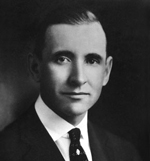
HONORING EXCELLENCE IN PATIENT ENGAGEMENT
Taylor Healthcare is pleased to sponsor the third annual John Q. Sherman Award for Excellence in Patient Engagement. The award was created to recognize the innovative work that has resulted in better, safer care and improved outcomes by engaging patients and families in their care.
This year’s award will be conferred by Taylor Healthcare in partnership with the National Patient Safety Foundation’s (NPSF) Lucian Leape Institute at the 2016 NPSF Patient Safety Congress in Scottsdale, Arizona on May 24 and the award-winning program will be featured on EngagingPatients.org.
For more information, please connect with us by email at award@engagingpatients.org or call 1-800-333-7782, Extension 9.
 |
ABOUT JOHN Q. SHERMANFounder of Standard Register, John Q. Sherman was a leading philanthropist in Dayton, Ohio with a deep commitment to healthcare and his community. At the onset of the Great Depression in 1928, he led the campaign to raise over one million dollars in just 30 days to build Good Samaritan Hospital. He left a legacy that lives on today through the company’s support of Dayton’s Samaritan Homeless Clinic, in the launching of EngagingPatients.org and now through the John Q. Sherman Award program. |
AWARD CRITERIA
The award is intended for healthcare provider institutions, organizations and
individuals (including providers, patients and families) who are directly involved in the care setting. It is not open to businesses that provide products, services or solutions to healthcare providers.
Nominees may be from the U.S. or Canada. Nominations will be judged on:
- Innovation: fresh,creative approach to advancing patient engagement
- Patient-centered: degree to which patients were involved
- Measurable results*, directly attributable to the initiative
- Potential for replication by other organizations and individuals
- Sustainability: achievements can be sustained over time
A WORD ABOUT RESULTS*
It is important to quantify the results.Results can come in many forms — from quality, financial and patient satisfaction metrics to testimonial stories that document the achievement. Present results in the manner you feel best represents this nominee’s achievement in patient engagement.
Work must have occurred between January 1, 2014 and January 21, 2016.
AWARD CATEGORIES
What type of programs or initiatives are eligible for submission? Judges will consider achievements in patient engagement of all types. These categories serve as examples:
| INNOVATION Tell us about how a creative ingenious program or approach has aligned patients, providers and families to improved patient care. Illustrate how innovations directly attributable to the nominee has improved patient engagement. | TRANSFORMATION Transformation can come in all shapes and sizes. Even the smallest changes can have an enormous downstream impact. Document how the nominee has transformed healthcare in the community or affected population. | COLLABORATION We want to celebrate those successful initatives that are building collaboration among patient, provider and family in care settings. Present examples of how the nominee fostered collaboration in the care environment or community. |
| COMMUNICATION Communication can take many forms, from print to verbal to non-verbal, and must be sensitive to the culture of the patient population. Document how the nominee made improvements in communication that led to improved patient engagement. | INSPIRATION Compassion, ingenuity and devotion are attributes that inspire caregivers and patients alike. Help us honor those who have inspired others through their actions and selflessness. Tell the story of how this nominee’s actions or initiatives has inspired others and resulted in better patient engagement. | SYSTEMS CHANGE Tell us about the nominee’s success in replacing an outdated intractable system with a more agile approach that allows for rapid change to meet patients’ discrete needs. Document how internal or external systems changes have impacted patient engagement. |
